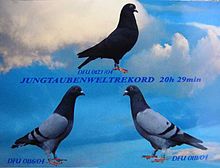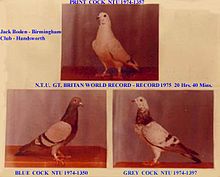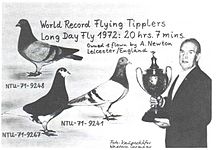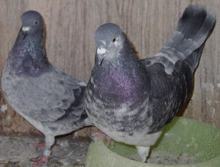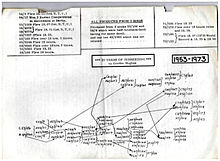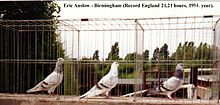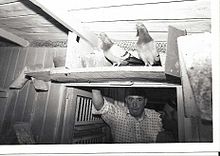- Tippler
-
- For railway usage, see Railroad car
A Tippler is a breed of domestic pigeon bred to participate in endurance competitions. Flying results of up to 22 hours (non-stop) have been reported (see photo at right).
Contents
Origin
All races of breeds of domestic pigeon have been evolved from the Rock Pigeon (Columba livia) that cohabits with man between the Mediterranean and China. The domestic pigeon breeds are believed to have been developed in the Middle East. As to the origin of the Tippler we are at a loss for accurate data. According to one theory, the Tippler is supposed to have been a cross between the Tumbler and the Cumulet in order to improve their flying qualities and give them a larger range of flight, that is, they rake more, which keeps them longer on the wing. This long-term flying has helped to get rid of the tumbling properties. There is no doubt that it is man-made through selective breeding. They are of Tumbler descent, but beyond this it is merely a matter of speculation. The breed is thought to be originated in Congleton and Macclesfield mining town in England, around the year 1845. The aim of the old time breeders was to perfect a graceful action of the wings, or "Butterfly Action" and it is the ease and grace with which the wings are used that enable the Tippler to attain its marvelous duration of flight. Wendell Levi in his book The Pigeon cites a reference from Hepworth (1893) who interviewed a W. Jolly of Mill Green who in 1893 stated that he had been breeding Tipplers for fifty six years. That would take the origin back to at least 1837. Levi also comments that the breed was developed around Rainow and Macclesfield, and goes on to mention "Macclesfield Tipplers", a strain or type of Tippler (See below), and that they were named after the region they were developed in.
Types
There are a number of well-known types of tipplers named after different breeders or the location they originated from. Most of these types have flown over 19 hours many times.
Hughes are, for instance, a type of tippler bred by Gordon Hughes in Derby, with a flying record of 18:07 in 1976, young birds.
Another famous type is the Boden bred by Jack Boden in Handsworth with a flying record of 20:40 in 1975, old birds. Bodens have also flown for over 20 hours many times.
"Sam Billingham", Arthur Newton, Joe Davies, and Jack Holland were also among the top breeders of England.
Other popular types include "Lovatt", "Merredith", Shannon also known as Irish Delight, and Sheffield which usually comes in colors red and yellow.
Training
Tipplers are very intelligent (see Pigeon intelligence) birds and can be trained to fly long hours and drop only when the trainer asks them to.
The following training program was published by W. Matthews in N.T.U. Yearbook 1987:
"Thirty-Six Stages for the Flying Tippler Novice".Competitions and flying rules
The Homing pigeon flies to race home, the Roller pigeon flies to roll, but the Tippler just flies and flies. The fanciers of Tipplers can compete against others anywhere in the world without leaving the confines of their own home. A kit of Tipplers consists of three or more pigeons. The tippler team is best when small; controlling and managing a small kit is in fact easier. Each Tippler club has a set of defined flying rules. Generally, the aim is to let the whole kit of Tipplers fly above/around the house for as long as possible. When one of the Tipplers lands, or if the fancier gives the landing sign, that is the end of the competition. Usually, the birds have to be seen every hour during serious competitions by the referee to make sure that they are indeed flying. Most clubs have their flying rules based on the "NTU flying rules".
There are two categories of competition: young birds and old birds. A young bird is one hatched during the current year, and in order to qualify for young bird competition, must bear a seamless band issued for that year. Any bird wearing a band issued for any previous year is regarded as an old bird regardless of its actual age. The first old bird race is usually about the middle of April, the rest following at two week intervals. The most important competition is organized on the so called Long Day. The longest day (usually in weekend) of the year.
International records
Top 5 Old Birds Record (h) Fancier Place Year 22:05 H. Shannon Ireland, Lisburn 1995 21;21 E. Anslow England, Springfild 1994 21:11 H. Shannon Ireland, Lisburn 1994 21:10 H. Culter Ireland, Ulster 1992 21:00 J Lamb Ireland, Crumlin 2001 Top 5 Young Birds Record (h) Fancier Place Year 20:29 Karl Kocholl Germany, Mudau 2004 20:01 P. van der Werf Holland, Oosterbierum 2002 19:55 A. Mahutian Holland, Harderwijk, 2001 19:40 H. Shannon Ireland, Lisburn 1993 19:34 Plester England, Birmingham 1990 Clubs
- National Tippler Union of Great Britain NTU
- National Flying Pigeon Association -INDIA [1]
- American Tippler Union ATU
- Bulgaria Tippler Club NTKBG
- Dutch Tippler Club [2]
- Flying Tippler Club of North America FTCNA
- The Flying Tippler Association of America FTA
- Canadian Tippler Union CNTU
- Russian Tippler Club RTC
- German Tippler Union DFU
- German Tippler Club TCD
- Croatia Tippler Union HTS
- Czech Tippler Club KCHT
- Nepal Pigeons Keeper Association NPKA
- Australian Flying Tippler Union (AFTU) [3]
See also
References
- 36 stages for the Flying Tippler Novice, W. Matthews, N.T.U. Yearbook 1987. Retrieved December 27, 2005.
- N.T.U. Yearbook 1990/1991. Retrieved November 5, 2006.
- "Flight Performance, Energetics and Water Turnover of Tippler Pigeons with a Harness and Dorsal Load", JA Gessaman, GW Workman, MR Fuller, 1991.
- The secrets of Tippler Pigeon Flying with 18 Invaluable Receipts by J Stanway
- Origins of the English Flying Tipplers by Jack Prescott, February 2006.
- Levi, Wendell (1977). The Pigeon. Sumter, S.C.: Levi Publishing Co, Inc. ISBN 0-85390-013-2.
Books
- CURLEY, J. T. 1961. The time-flying tippler pigeon sport. Howell Book House, New York, NY. [4]
External links
Categories:- Domesticated pigeon breeds
- Pigeon sport
Wikimedia Foundation. 2010.


